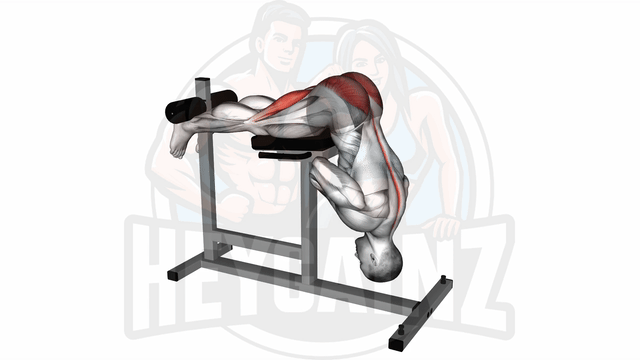
Instructions:
- 1Begin by positioning your body face down on the hyperextension bench, with foot pads against your lower calves
- 2Lower your upper body by bending hips until fully flexed
- 3Raise your body until your hips and waist are fully extended
- 4Repeat the movement
Tips:
- Avoid arching your back beyond a straight line
- Keep your head in neutral position
- Exhale as you raise your upper body and inhale as you lower
- Engage your core for stability
Understanding the Hyperextension Exercise
The hyperextension is a valuable exercise aimed at strengthening the erector spinae muscles, which play a crucial role in maintaining proper posture and spinal alignment. Primarily targeting the hips, this bodyweight exercise can also contribute to improving overall flexibility and stability in the lower back and glutes.
While the hyperextension can be effectively performed using just bodyweight, it is often enhanced by utilizing a hyperextension bench, which allows individuals to achieve a greater range of motion. This exercise is sometimes referred to as a back extension, particularly when performed on a hyperextension machine, where the individual supports their hips on a padded surface to execute the movement safely and effectively.
Getting Started with Hyperextensions
To perform a hyperextension, follow these steps:
- Begin by positioning yourself on the hyperextension bench or flat surface with your hips aligned with the edge.
- Secure your feet and engage your core by tightening your abdominal muscles.
- Lower your upper body towards the ground, maintaining a neutral spine position.
- Slowly raise your torso back to starting position, squeezing your glutes and lower back muscles at the top.
Tips for Effective Hyperextensions
- Focus on form over quantity—ensure each movement is controlled to prevent injury.
- Incorporate breathing techniques by exhaling at the top of the movement, which helps engage the core more effectively.
- If you're new to this exercise, start with body weight before using added weights or advanced equipment.
- Consider varying your stance to work different areas of the target muscles, such as adjusting your foot positioning to also focus on the glutes.
Lastly, be mindful of hyperextension of the neck, which can occur if the head is positioned improperly during the movement. Keeping your neck aligned with your spine will help avoid strain.
Incorporating hyperextensions into your regular workout routine can significantly contribute to building a stronger, more resilient back, while aiding in injury prevention and enhancing athletic performance.